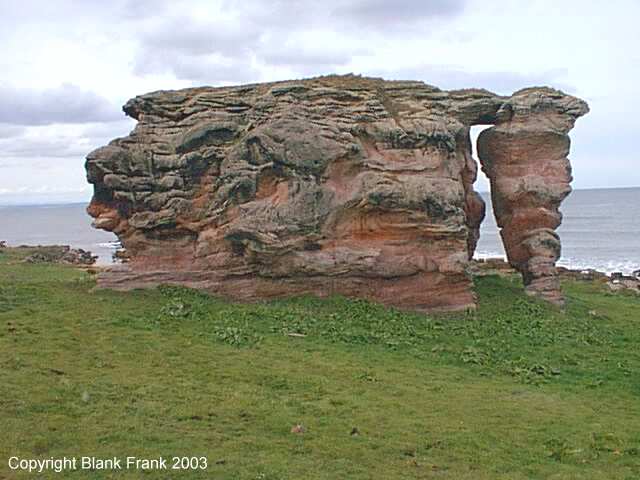
Continuing the theme of interesting lumps of stone with names, here's one I visited near St Andrews on the East Fife Coast.

If this thing had lungs, vocal cords, a nervous system, knowledge of language and suitable motivation, I'm pretty sure it would speak for itself. As far as I can tell, it has few - if any - of the above, so I'll have a bash. Looking at a map and seeing something marked Buddo Rock does little to prepare you for the reality of what is actually there. It's BIG - at a rough estimate, 10 metres high and 22 metres wide. It is not as obviously designed for space travel as Ayers Rock - your guess is as good as mine as to how far you would need to dig down to expose the rocket motors.
Buddo Rock is a big lump of sandstone standing in isolation on the seashore. I am not a geologist, but it seems obvious to me that it was once part of the surrounding sandstone shelf. The softer stuff was eroded by sea, wind, rain etc leaving this lump some distance apart from the rest of the shelf. The crinkly texture of the eroded surface is a joy to behold, as are the various holes and structures. The range of colours is staggering when you study it carefully. On the side not visible in the photograph is a natural cleft, augmented by a little human effort, which provides a route part of the way up through the middle of the rock - it does not, however, provide an easy route to the top, an attempt on which would engender considerable risk. To my surprise, on this occasion I actually decided against trying it, but on reflection later on, I agreed with myself that it wasn't worth dying for. It is clear from the attempts at monumental carving visible on the surface that the rock is quite a popular place to visit, but the vandalism is less offensive to the eye than on some rocks (eg the Bonnet Stane) because the size of it makes the marks insignificant except in extreme close-up. I would like to fill you with wild tales of how in ancient times the locals used to crawl backwards three times through the rock arch at sunset on the eve of important football matches to ensure a good score on the big day, good crops, fame, fortune and so on, but I'd just be making it up - retroactive folklore is something I generally leave to others.
Access to this site is relatively easy. The OS Grid Reference is NO 56324 15009. It is on the Fife Coastal Path, and can be approached from St Andrews to the West or Boarhills to the SE. I drove into Boarhills from the A917 - Boarhills is a small, attractive settlement, with not much in the way of carparks, so you want to be considerate about where you abandon the car - I left mine close to a wall near the highest point on the road leading Northwards from the centre of the village (NO 56587 14161). From there, Buddo Rock is 0.55 mile in a direct line on a bearing of 342 degrees, but the walked route is probably about 0.75 mile - fairly gentle footpath most of the way, with a steeper, muddier bit near the rock. Walk North on the road until you come to a Doocot and some large farm buildings - you should see a signpost for the coastal path here, and at various other points along the route. Head NW along the well-used farm track for 200 metres then North down the side of a field for another 400 metres. The path then heads briefly West, over a stile then downhill towards a sheltered bay area where the rock lives. As you get closer, the rock starts to stand out from the background.
It's worth a look if you like that sort of thing - nothing much more to say.
The faint background image on this page is my hand-drawn map to the site. You can snag the image, tweak the colours and print it out.
If you like this rock, you might consider having a nose at other lumps of stone on these pages -